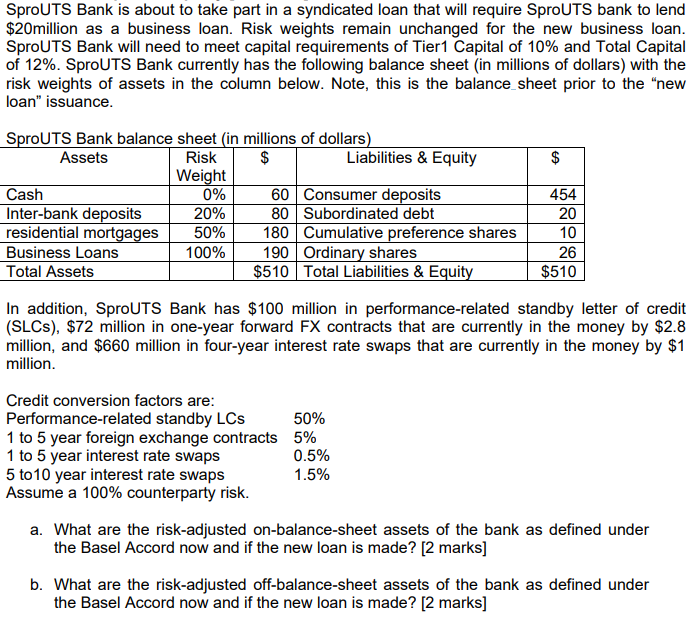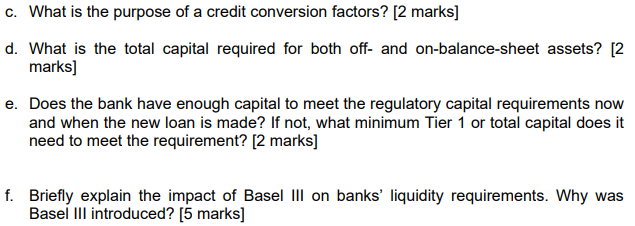

SproUTS Bank is about to take part in a syndicated loan that will require SproUTS bank to lend $20 million as a business loan. Risk weights remain unchanged for the new business loan. SproUTS Bank will need to meet capital requirements of Tier1 Capital of 10% and Total Capital of 12%. SproUTS Bank currently has the following balance sheet (in millions of dollars) with the risk weights of assets in the column below. Note, this is the balance sheet prior to the "new loan" issuance. $ SproUTS Bank balance sheet (in millions of dollars) Assets Risk $ Liabilities & Equity Weight Cash 0% 60 Consumer deposits Inter-bank deposits 20% 80 Subordinated debt residential mortgages 50% 180 Cumulative preference shares Business Loans 100% 190 Ordinary shares Total Assets $510 Total Liabilities & Equity 454 20 10 26 $510 In addition, SproUTS Bank has $100 million in performance-related standby letter of credit (SLCs), $72 million in one-year forward FX contracts that are currently in the money by $2.8 million, and $660 million in four-year interest rate swaps that are currently in the money by $1 million. Credit conversion factors are: Performance-related standby LCs 50% 1 to 5 year foreign exchange contracts 5% 1 to 5 year interest rate swaps 0.5% 5 to 10 year interest rate swaps 1.5% Assume a 100% counterparty risk. a. What are the risk-adjusted on-balance-sheet assets of the bank as defined under the Basel Accord now and if the new loan is made? [2 marks] b. What are the risk-adjusted off-balance-sheet assets of the bank as defined under the Basel Accord now and if the new loan is made? [2 marks] c. What is the purpose of a credit conversion factors? [2 marks] d. What is the total capital required for both off- and on-balance-sheet assets? [2 marks] e. Does the bank have enough capital to meet the regulatory capital requirements now and when the new loan is made? If not, what minimum Tier 1 or total capital does it need to meet the requirement? [2 marks] f. Briefly explain the impact of Basel III on banks' liquidity requirements. Why was Basel III introduced? [5 marks] SproUTS Bank is about to take part in a syndicated loan that will require SproUTS bank to lend $20 million as a business loan. Risk weights remain unchanged for the new business loan. SproUTS Bank will need to meet capital requirements of Tier1 Capital of 10% and Total Capital of 12%. SproUTS Bank currently has the following balance sheet (in millions of dollars) with the risk weights of assets in the column below. Note, this is the balance sheet prior to the "new loan" issuance. $ SproUTS Bank balance sheet (in millions of dollars) Assets Risk $ Liabilities & Equity Weight Cash 0% 60 Consumer deposits Inter-bank deposits 20% 80 Subordinated debt residential mortgages 50% 180 Cumulative preference shares Business Loans 100% 190 Ordinary shares Total Assets $510 Total Liabilities & Equity 454 20 10 26 $510 In addition, SproUTS Bank has $100 million in performance-related standby letter of credit (SLCs), $72 million in one-year forward FX contracts that are currently in the money by $2.8 million, and $660 million in four-year interest rate swaps that are currently in the money by $1 million. Credit conversion factors are: Performance-related standby LCs 50% 1 to 5 year foreign exchange contracts 5% 1 to 5 year interest rate swaps 0.5% 5 to 10 year interest rate swaps 1.5% Assume a 100% counterparty risk. a. What are the risk-adjusted on-balance-sheet assets of the bank as defined under the Basel Accord now and if the new loan is made? [2 marks] b. What are the risk-adjusted off-balance-sheet assets of the bank as defined under the Basel Accord now and if the new loan is made? [2 marks] c. What is the purpose of a credit conversion factors? [2 marks] d. What is the total capital required for both off- and on-balance-sheet assets? [2 marks] e. Does the bank have enough capital to meet the regulatory capital requirements now and when the new loan is made? If not, what minimum Tier 1 or total capital does it need to meet the requirement? [2 marks] f. Briefly explain the impact of Basel III on banks' liquidity requirements. Why was Basel III introduced? [5 marks]








